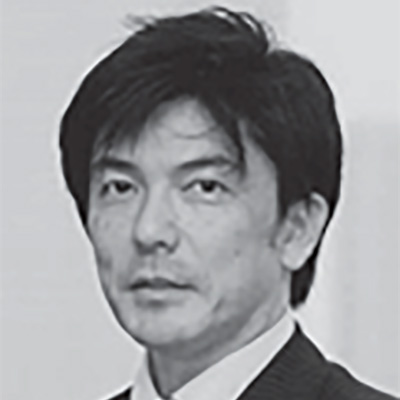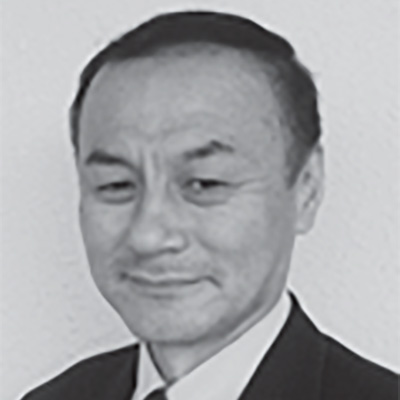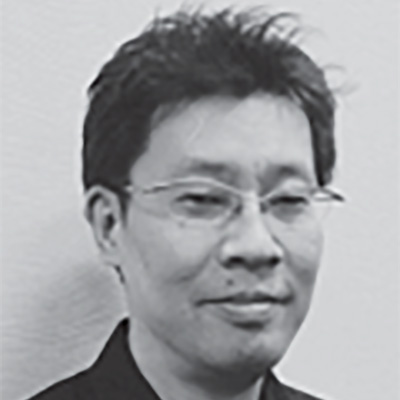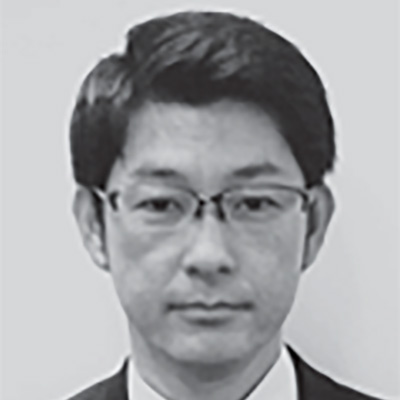—From Buildings to Cities—
Japan’s urban real estate market must satisfy constantly changing demands amid societal challenges and lifestyle changes brought on by the shrinking workforce (caused by Japan’s aging population and falling birthrate), and by energy, disaster, and security problems. The sales team of Hitachi Ltd.’s Building Systems Business Unit is aiming to combine sales growth in elevator equipment and other product lineups, with the Social Innovation Business created by partnering with customers to plan and create solutions to urban challenges. Hitachi is working on energy management for smart cities by harnessing infrastructure and IT to create services of value to end users. It has also worked on automatic power control systems supporting BCP contingency measures through joint development of solutions to office tenant challenges.

Business Partner Sales Department, Account Sales Division 1, Sales Group, Building Systems Business Unit, Hitachi, Ltd. (Hitachi Building Systems Co., Ltd.) He is currently engaged in partner sales in the urban sector.

Business Partner Sales Department, Account Sales Division 1, Sales Group, Building Systems Business Unit, Hitachi, Ltd. He is currently engaged in partner sales in the urban sector.

Business Partner Sales Department, Account Sales Division 1, Sales Group, Building Systems Business Unit, Hitachi, Ltd. He is currently engaged in partner sales in the urban sector.

Project Promotion Group, Solutions Business Promotion Division, Power Information Control Systems Division, Energy Solutions Business Unit, Hitachi, Ltd. He is currently engaged in the development of business related to the energy sector.

Kashiwanoha Project, Total Engineering Division 2, Social Innovation Business Division, Hitachi, Ltd. He is currently engaged in collaborative business with customers in sectors related to smart cities, and the business development.

Customer Co-Creation Project, Global Center for Social Innovation – Tokyo, Research & Development Group, Hitachi, Ltd. He is currently engaged in collaborative business with customers in the urban and traffic sectors, in vision creation, and in the science of service design. Dr. Minemoto is a member of the Japanese Society for the Science of Design (JSSD), and the Architectural Institute of Japan (AIJ), and is a part-time professor at a graduate school of Hosei University.

Customer Co-Creation Project, Global Center for Social Innovation – Tokyo, Research & Development Group, Hitachi, Ltd. She is currently engaged in collaborative business with customers in the urban and traffic sectors, in vision creation, and in the science of service design. Ms. Doi is a member of the JSSD.

Security & Image Solutions Division, PSS Promotion Division, Hitachi Information Control Systems, Ltd. He is currently engaged in the development of business related to the building system sector.
JAPAN is facing an increasingly severe and diverse range of challenges, such as energy shortages, damage from earthquakes and other disasters, and security measures. Seeking to provide solutions to Japan's urban problems, Hitachi, Ltd. has partnered with leading Japanese real estate developer Mitsui Fudosan Co., Ltd. to create the Kashiwa-no-ha Area Energy Management System (AEMS). Hitachi has also co-developed an automatic power control system that supports business continuity plan (BCP) contingency measures. This system was created to accommodate the changing needs of the tenants (end users) who occupy the office buildings forming the core of Japan's real estate industry.
While Hitachi sales team members can always obtain various types of information faithfully on behalf of customers, understanding the needs and wants of customers and conveying them throughout Hitachi is challenging. Customers can sometimes have trouble expressing their own needs and wants, making them difficult to assess. And while problem-solving is simple for standalone products, proposing solutions to complex problems requires collaborative creation among several different departments and employees.
This article discusses how Hitachi's Building Systems Business Unit is looking to shape its front-line sales activities in the future to reflect information such as knowledge acquired from collaborative cooperation projects.
Re-zoning work for Kashiwa-no-ha Smart City began in 2000 under an urban development plan for the city of Kashiwa, in Chiba prefecture. Development started around train stations, beginning with the opening of the Tsukuba Express rail line and Kashiwanoha-campus Station. In 2008, the Kashiwa-no-ha International Campus Town Initiative was announced by a consortium of public, private, and academic organizations led by the governments of Chiba prefecture and the city of Kashiwa, along with Mitsui Fudosan, and universities such as the University of Tokyo and Chiba University(1). Through the initiative, Mitsui Fudosan has identified three societal challenges that will define Kashiwa-no-ha Smart City—an Environmental-Symbiotic City, a City of New Industry Creation, and a City of Health and Longevity. The city will aim to become a model for sustainable urban development, and has received worldwide attention.
Hitachi has partnered with Mitsui Fudosan to create Kashiwa-no-ha AEMS(2). Unlike previous building system projects, Kashiwa-no-ha AEMS has required new sales team activities in the areas of urban development and energy systems, with development work to reduce future environmental impact and implement solutions in cities. The areas of particular concern are urban value and the products and technologies used to create it. Hitachi's initial role in the project was delivering elevators and security equipment for Mitsui Fudosan's commercial facilities and multi-unit housing, but since the Kashiwa-no-ha concept coincides with the concept Hitachi had been seeking for its work on smart cities, it started to study problem-solving models for the city's key objective of an Environmental-Symbiotic City (see Fig. 1)(3).
Fig. 1—Changing Role of Hitachi’s Sales Team.
 The diagram shows the new activities being done by Hitachi’s sales team, illustrating how the team’s role has changed from building equipment installation work to proposing solutions for urban development and energy management system development. The team worked to meet the initial customer demands for Kashiwa-no-ha Smart City by installing equipment for the city’s commercial development. With its expansion into urban-district energy management systems, the team has been taking on significantly different roles by coordinating with various stakeholders and Hitachi representatives, and taking part in study discussions. The relationships the team has built with customers have also enabled it to play a leading role within Hitachi for the study of future concepts and the dissemination of information.
The diagram shows the new activities being done by Hitachi’s sales team, illustrating how the team’s role has changed from building equipment installation work to proposing solutions for urban development and energy management system development. The team worked to meet the initial customer demands for Kashiwa-no-ha Smart City by installing equipment for the city’s commercial development. With its expansion into urban-district energy management systems, the team has been taking on significantly different roles by coordinating with various stakeholders and Hitachi representatives, and taking part in study discussions. The relationships the team has built with customers have also enabled it to play a leading role within Hitachi for the study of future concepts and the dissemination of information.
Urban energy management was primarily studied from the perspective of CO2 reduction until the 2011 Great East Japan Earthquake increased worldwide demand for ways of ensuring business and lifestyle continuity during power failures. There have been calls to meet both needs since then. Hitachi has attempted to create Japan's first urban-district power exchange system for four districts zoned for different purposes (commercial, office, hotel, and residential). It connected the districts with dedicated power lines, and combined large-capacity storage batteries with power generation facilities in commercial facilities and office buildings such as renewable energy facilities. The system reduces contract power through peak shaving during normal operation, and can supply power during widespread power failures or other emergencies to enable business and lifestyle continuity throughout the entire city. Overall energy management is done by the Kashiwa-no-ha Smart Center, which keeps track of the current energy consumption and creates forecasts of the entire city's power demand to provide guidance on optimal energy usage for the entire city.
At this point, Hitachi's sales team worked primarily on finding ways of providing high-quality products with good cost performance from the specifications provided by the customer. Working with the customer to consider the value to provide, the sales team faced setbacks from its limited experience of the processes used to create the systems needed to overcome the obstacles it faced. The project gave the sales team its first experience with energy industry work. It required assistance from other Hitachi departments and outside organizations such as construction companies, energy companies, and government agencies for coordination and ancillary construction work.
While prolonged discussions with the customer eventually led to the delivery of the energy management system and other systems, it was recognized that there was a need to tie the original mission to a radical change in thinking among the sales team. The following questions were asked:
The Hitachi's unfamiliarity with the real estate industry made it difficult to gain an adequate understanding of the values of customers in that industry, and with the issues they face. Fortunately, most end users of the real estate industry are consumers, which allowed Hitachi to draw on its many years of experience with the business-to-business-to-consumer (B2B2C) approach it has refined through its elevator business. This approach enabled it to align the values to be considered with its own values in some cases. Creating AEMS required long-term collaboration between Hitachi and Mitsui Fudosan to consider and discuss the needs and wants of residents, workers, and visitors. The aim was to create systems that are able to genuinely meet these needs and wants. A diverse range of Hitachi departments and employees were involved with the project, so the coordination and consolidation abilities of the sales team played a key role in project management on behalf of the customer.
While Mitsui Fudosan has taken the lead in this project (drawing on its wealth of experience in large-scale urban development and operation), Hitachi will need to study and implement projects using the same perspectives and approaches in the future. It will need to identify the needs of users and listen to their input to create more systems of value.
Stage 1 of Kashiwa-no-ha Smart City opened in July 2014, and the idea is that the city will gradually mature over time, according to Mitsui Fudosan's concept of Keinen Yuuka (Mature with age), as system hardware and software are refined and expanded. To do this, the sales team has coordinated the project throughout Hitachi, identifying the needs of the region's users from societal trends, and has guided the project that will shape Kashiwa-no-ha over the next decade. Hitachi has continued to work on collaborative creation activities to create multiple visions for future cities, and the study results have been used by Mitsui Fudosan and Hitachi members in activities such as projects for short-term residents of multi-unit housing.
To prepare for a future decline in new building construction demand in Japan, Building Systems Business Unit will need to move its focus away from new elevator sales, and increase the work it does on equipment replacement and solutions. Hitachi's sales team has been using the results of urban development collaborative creation activities to further expand its mission of identifying market needs, devising solutions, and applying those solutions to manufacturing and other activities. Hitachi's automatic power control system supporting BCP contingency measures is an example of a system created through these activities(4).
Fig. 2—Sales Team’s Work on Joint Development with a Customer.
 The sales team has worked on developing solutions to a customer’s real estate supply issues by drawing on the expertise of both the customer and Hitachi (as tenant).
The sales team has worked on developing solutions to a customer’s real estate supply issues by drawing on the expertise of both the customer and Hitachi (as tenant).
Like the Kashiwa-no-ha project, the automatic power control system supporting BCP contingency measures illustrates how the ability to draw on Hitachi technologies and experience to provide value to customer projects will be important in the future.
Business continuity during power failures have become an important issue since the Great East Japan Earthquake. But massive equipment investment to prepare for power failures that could occur at any time is a major burden for building developers. Developers seek to minimize the cost of this equipment, and since Mitsui Fudosan is no exception, it partnered with Hitachi to jointly develop a system for effective power use. The system uses the surplus generation capacity of emergency generators. Non-fire-related power failures leave about 50 to 60% of emergency generator capacity available for use as surplus power (see Fig. 2).
Hitachi's automatic power control system supporting BCP contingency measures is designed to enable maximally effective use of power from existing emergency generators. It was developed through collaborative creation between Mitsui Fudosan and Hitachi. It will be provided to office buildings and public facilities to help improve the BCP contingency measures of companies and buildings, and to help ensure disaster-resistant urban development.
By providing power to work spaces in buildings occupied by companies during non-fire-related power failures, the automatic power control system supporting BCP contingency measures enables companies to power their disaster response centers, improving the BCP contingency measures of buildings and companies. The system consists of monitoring control equipment and new distribution boards (with control units) installed on main power lines. The monitoring control equipment automatically sends a mode signal to the control units of the distribution boards after setting the operation mode in accordance with signals that indicate statuses, such as building power failure, emergency generator operation, and fire. The control units enable efficient distribution of the limited surplus power as indicated by the received mode signal. The surplus power is divided uniformly among multiple distribution boards, or sent to a disaster response center or elsewhere as needed. When using a main power line carrying the commercial power supply for an existing building, the system can be constructed for about half of the installation time and cost needed for conventional power failure response measures*.
Not every customer can take part in customer collaborative creation activities or become a business partner. Genuine needs can only be identified by aligning corporate management policies and by building trust. The automatic power control system supporting BCP contingency measures is the result of a successful match between Mitsui Fudosan's expertise in disaster response improvement and BCP support for building operations, and Hitachi's portfolio of engineering and technical competencies in building management systems tailored to customer needs. Building Systems Business Unit also recognized the demands that the project placed on its sales team. Along with their usual salesmanship, sales team members required the leadership and management skills necessary to coordinate various related departments.
Fig. 3—Sales Team’s Work on Urban Development Driven by Science and Technology.
 Working toward the future of urban development, the sales team is taking part in collaborative creation activities with a wide range of partners, playing an active role in creating long-term visions for smart city environments that are enabled by scientific and technological demonstration.
Working toward the future of urban development, the sales team is taking part in collaborative creation activities with a wide range of partners, playing an active role in creating long-term visions for smart city environments that are enabled by scientific and technological demonstration.
Hitachi's sales team has traditionally been a product-driven front-line organization working primarily on delivering, maintaining, and modernizing elevators and other building equipment in new buildings. Its customers have been primarily real estate developers and construction companies. The Kashiwa-no-ha AEMS and automatic power control system projects illustrate how this role is changing.
In April 2015, Hitachi reshuffled its research and development (R&D) organization, created a customer-originated collaborative creation center, and merged the Sales Division and Social Innovation Business Division. In April 2016, it reshuffled the internal branch company organizations and affiliates as business units. These changes have created a more unified, customer-facing organization that extends from the sales team to the business divisions and R&D. Various collaborative creation activities with Mitsui Fudosan have enabled cross-organizational work connecting outside and in-house organizations. In the years ahead, the sales team will be called on to play many different leading roles for business projects targeting both short-term and medium- to long-term results. By working with customers to examine their changing situations and anticipated future risks, Hitachi intends to continue helping to create a smart society that can provide high-quality services to the recipients who need them, at the required timing, and in the required quantity, across the boundaries of age, gender, region, and language (see Fig. 3).
Smart city development projects hold the potential to create value from the birth of unprecedented new cities that allow residents, workers, and visitors to share their resources, energy, possessions, space, knowledge, and data. A group led by the Cabinet Office, Government of Japan and the Japan Business Federation (Keidanren) has proposed a Super Smart Society (Society 5.0) driven by science and technology. Hitachi needs to contribute to this project by drawing on the IT and infrastructure technologies and expertise it has accumulated in a variety of industries. Smart cities such as Kashiwa-no-ha will require Hitachi's sales team to stay continually up-to-date with ever-changing societal challenges and market demands, while connecting them with Hitachi resources. Reviews of value-related feedback and problems will need to continue after delivery, leading to the creation of the next generation of systems. Each region has widely varying issues and needs. Hitachi's sales team will need to gain a global understanding of issues, and work with customers to study and implement solutions that reflect a solid understanding of regional lifestyles and culture.
As Hitachi's front-line business unit, Building Systems Business Unit is tasked with the mission of continually keeping up-to-date with future changes, indicators, and risks, while working with customers to create growing business models.
The authors would like to express their heartfelt appreciation for the valuable input they received on-site from Mitsui Fudosan employees during the development of Kashiwa-no-ha AEMS and the automatic power control system supporting BCP contingency measures.